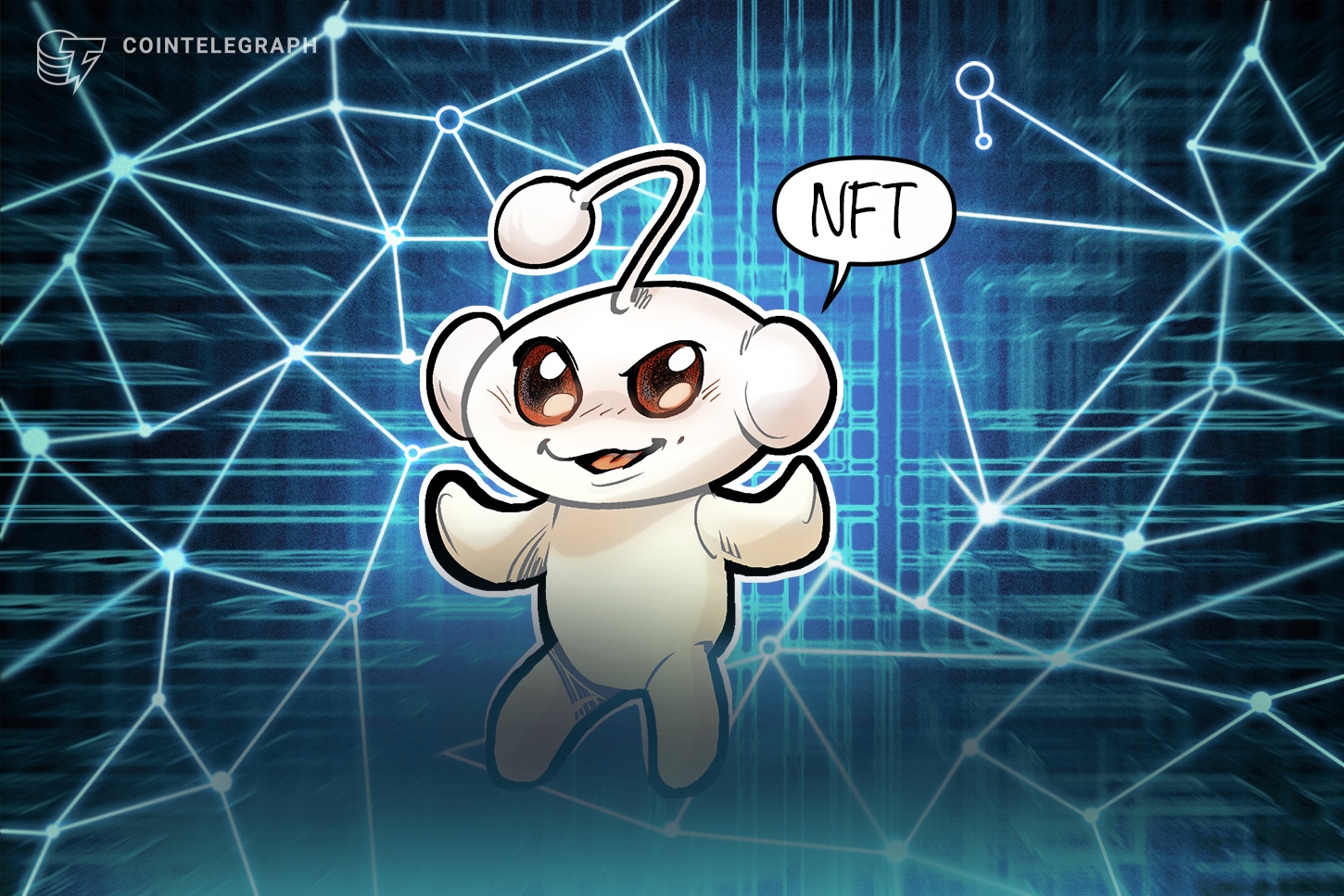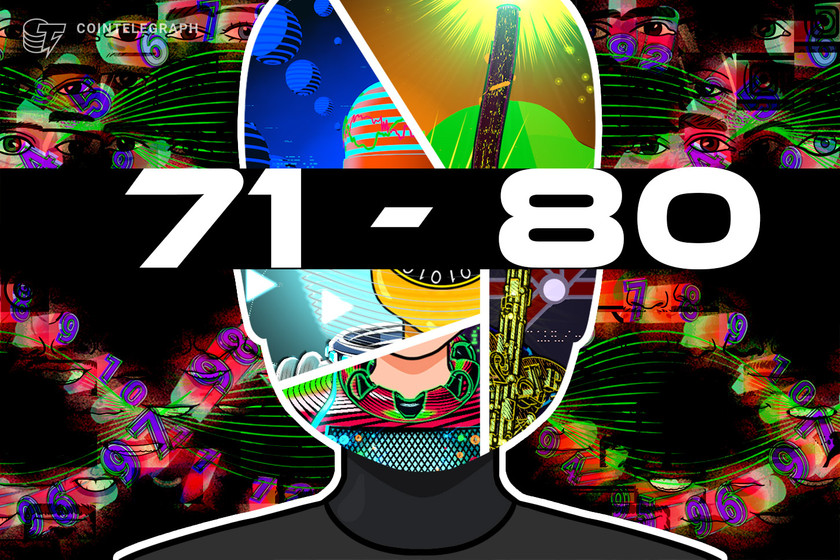What are Bitcoin ordinals?
What is Bitcoin? How does blockchain work? How to mine cryptocurrency? We are glad to help you answer these questions with our quick guides in Explained section.
rn”,”seo_description”:”What is Bitcoin? How does blockchain work? How to mine cryptocurrency? We are glad to help you answer these questions with our quick guides in Explained section.”},”words_count”:962,”description”:”Bitcoin ordinals have been the most hyped-up Web3 trend of 2023 so far. How do ordinals compare to traditional NFTs, and what are the opportunities?”,”author”:{“id”:1587,”title”:”Arunkumar Krishnakumar”,”url”:”arunkumar-krishnakumar”,”twitter”:””,”google_plus”:””,”photo”:”https://s3.cointelegraph.com/storage/uploads/view/9eb8857e029ccc4cb084a3acb28859e1.jpg”,”gender”:”male”,”description”:”Arun is the chief growth officer at Bullieverse. With a career spanning 20 years, Arun has spent time as a technology engineer, consultant, VC/Web3 investor and author. As an investor, he has over 20 portfolio companies, a few exits and sits on several boards. Arun has published two books, one on Web3 and the other on crisis management for venture firms. He is a social media influencer and an alum of the University of Oxford and the London School of Economics. Arun also has a crypto (mostly L1s) and an NFT portfolio (both PFPs and Utility). “,”facebook”:””,”email”:””,”linkedin”:””,”created_at”:”2022-06-11 15:35:40″,”updated_at”:”2022-09-20 20:09:37″,”deleted_at”:null,”innovation_circle_url”:null,”avatar”:”https://images.cointelegraph.com/images/150_aHR0cHM6Ly9zMy5jb2ludGVsZWdyYXBoLmNvbS9zdG9yYWdlL3VwbG9hZHMvdmlldy85ZWI4ODU3ZTAyOWNjYzRjYjA4NGEzYWNiMjg4NTllMS5qcGc=.jpg”,”hash”:”aHR0cHM6Ly9jb2ludGVsZWdyYXBoLmNvbS9hdXRob3JzL2FydW5rdW1hci1rcmlzaG5ha3VtYXI=”,”relativeUrl”:”https://cointelegraph.com/authors/arunkumar-krishnakumar”,”user_id”:1587,”language_id”:1,”name”:” Arunkumar Krishnakumar “,”desc”:”Arun is the chief growth officer at Bullieverse. With a career spanning 20 years, Arun has spent time as a technology engineer, consultant, VC/Web3 investor and author. As an investor, he has over 20 portfolio companies, a few exits and sits on several boards. Arun has published two books, one on Web3 and the other on crisis management for venture firms. He is a social media influencer and an alum of the University of Oxford and the London School of Economics. Arun also has a crypto (mostly L1s) and an NFT portfolio (both PFPs and Utility). “,”seo_title”:””,”seo_description”:””,”enabled”:1,”show_in_authors”:0,”show_in_experts”:0},”category_id”:65,”audio”:”https://s3.cointelegraph.com/audio/104175.7158688e-4d7f-4a89-b0c9-7c83e9683be1.mp3″,”tags”:[{“name”:”Bitcoin”,”uri”:”/tags/bitcoin”,”super”:1,”page_title”:”Bitcoin News”},{“name”:”Blockchain”,”uri”:”/tags/blockchain”,”super”:1,”page_title”:”Blockchain News”},{“name”:”Ethereum”,”uri”:”/tags/ethereum”,”super”:1,”page_title”:”Ethereum News”},{“name”:”Artists”,”uri”:”/tags/artists”,”super”:0,”page_title”:”Artists News”},{“name”:”NFT”,”uri”:”/tags/nft”,”super”:1,”page_title”:”NFT News”}],”tag_title”:”Bitcoin”,”date”:”24 MINUTES AGO”,”badge”:{“title”:”Explained”,”label”:”default”},”qty”:5,”stats_pixel”:”“,”stats_pixel_url”:”https://zoa.cointelegraph.com/pixel?postId=104175®ionId=1″,”shares”:2,”infographic”:false,”sponsored”:false,”explained”:true,”press_release”:false,”show_referral”:false,”social_description”:”Bitcoin ordinals are NFTs on the Bitcoin blockchain. Why are they special, and what are the key features of Bitcoin ordinals?”,”social_translators”:{“clipboard_popup_label”:”Link copied”,”socialWechatFooterError”:”WeChat error”,”socialWechatFooterText”:”WeChat share”,”socialWechatHeaderText”:”WeChat share”},”social_shares”:{“post_id”:104175,”post_url”:”https://cointelegraph.com/explained/what-are-bitcoin-ordinals”,”post_titles”:{“normal”:”What are Bitcoin ordinals?”,”twitter”:”What are Bitcoin ordinals?”},”post_text”:{“normal”:”What are Bitcoin ordinals?”,”twitter”:”What are Bitcoin ordinals? https://cointelegraph.com/explained/what-are-bitcoin-ordinals via @cointelegraph”},”accounts”:{“twitter”:”@cointelegraph”}},”socials”:{“facebook”:{“url”:”https://www.facebook.com/sharer/sharer.php?u=https%3A%2F%2Fcointelegraph.com%2Fexplained%2Fwhat-are-bitcoin-ordinals”,”count”:null,”short”:”fb”,”fa”:”facebook”},”twitter”:{“url”:”https://twitter.com/intent/tweet?text=What+are+Bitcoin+ordinals%3F https%3A%2F%2Fcointelegraph.com%2Fexplained%2Fwhat-are-bitcoin-ordinals via @cointelegraph”,”count”:null,”short”:”tw”,”fa”:”twitter”},”telegram”:{“url”:”https://telegram.me/share/url?url=https%3A%2F%2Fcointelegraph.com%2Fexplained%2Fwhat-are-bitcoin-ordinals &text=What+are+Bitcoin+ordinals%3F”,”count”:null,”short”:”tg”,”fa”:”paper-plane”},”whatsapp”:{“url”:”https://api.whatsapp.com/send?text=What+are+Bitcoin+ordinals%3F&href=https%3A%2F%2Fcointelegraph.com%2Fexplained%2Fwhat-are-bitcoin-ordinals”,”count”:null,”short”:”wu”,”fa”:”whatsapp”},”gplus”:{“url”:”https://plus.google.com/share?url=https%3A%2F%2Fcointelegraph.com%2Fexplained%2Fwhat-are-bitcoin-ordinals”,”count”:null,”short”:”gplus”,”fa”:”google-plus”},”reddit”:{“url”:”https://www.reddit.com/submit?url=https%3A%2F%2Fcointelegraph.com%2Fexplained%2Fwhat-are-bitcoin-ordinals&title=What+are+Bitcoin+ordinals%3F”,”count”:null,”short”:”reddit”,”fa”:”reddit-alien”},”linkedin”:{“url”:”https://www.linkedin.com/shareArticle?mini=true&url=https%3A%2F%2Fcointelegraph.com%2Fexplained%2Fwhat-are-bitcoin-ordinals&title=What+are+Bitcoin+ordinals%3F”,”count”:null,”short”:”li”,”fa”:”linkedin”}},”hide_disclaimer”:false,”elink”:”https://cointelegraph.com”,”etitle”:”Cointelegraph”,”elogo_x2″:”https://images.cointelegraph.com/images/528_aHR0cHM6Ly9zMy5jb2ludGVsZWdyYXBoLmNvbS9zdG9yYWdlL3VwbG9hZHMvdmlldy9hYjAzYTJhMmNlOWEyMWRjMWYwOTYxZDkxNzMxYzhiYS5wbmc=.png”,”elogo_x1″:”https://images.cointelegraph.com/images/260_aHR0cHM6Ly9zMy5jb2ludGVsZWdyYXBoLmNvbS9zdG9yYWdlL3VwbG9hZHMvdmlldy9hYjAzYTJhMmNlOWEyMWRjMWYwOTYxZDkxNzMxYzhiYS5wbmc=.png”,”elogo_svg”:false,”content”:[{“id”:3978,”post_id”:104175,”title”:”What are Bitcoin NFTs?”,”content”:”
Bitcoin NFTs — aka Bitcoin ordinals, aka digital artifacts — are a way to inscribe digital content on the Bitcoin blockchain.
nn
The Bitcoin ordinals protocol was launched in January 2023 by Casey Rodarmor. The protocol allows inscribing of digital content like art onto the Bitcoin blockchain. Unlike nonfungible tokens (NFTs) on Ethereum and other blockchains, Rodarmor wanted to create an immutable on-chain presence of a piece of art, text or video. The genesis ordinal was a pixel art of a skull that Rodarmor inscribed on Dec. 14, 2022.
nn
As the NFT space based on Ethereum’s ERC-721 standard skyrocketed in 2021, Rodarmor, who was a programmer and an artist, saw the opportunity to create a similar yet unique experience on the Bitcoin blockchain. His solution was Bitcoin ordinals, based on ordinal theory, which he went on to implement through 2022.
nn
Ordinal theory concerns itself with satoshis, giving them individual identities and allowing them to be tracked, transferred and imbued with meaning. The ordinals hype really kicked off in February 2023, six weeks after the genesis ordinal was created.
nn
The number of inscriptions doubled every week for a few weeks. However, the number could have been much higher if the infrastructure to inscribe and trade ordinals had been better planned and executed.
nn

nn
The rise of Bitcoin ordinals has seen the Bitcoin network explode in terms of usage, fees and storage space as shown in the chart above. This may also be the first big breakthrough for the Bitcoin application tier and can help move the narrative from a pure “store of value” to something more utilitarian.
nnn”,”created_at”:”2023-03-09 08:19:46″,”updated_at”:”2023-03-09 08:23:19″,”sort”:1,”translations”:{“id”:3971,”explained_post_id”:3978,”title_en”:”What are Bitcoin NFTs?”,”content_en”:”
Bitcoin NFTs — aka Bitcoin ordinals, aka digital artifacts — are a way to inscribe digital content on the Bitcoin blockchain.
nn
The Bitcoin ordinals protocol was launched in January 2023 by Casey Rodarmor. The protocol allows inscribing of digital content like art onto the Bitcoin blockchain. Unlike nonfungible tokens (NFTs) on Ethereum and other blockchains, Rodarmor wanted to create an immutable on-chain presence of a piece of art, text or video. The genesis ordinal was a pixel art of a skull that Rodarmor inscribed on Dec. 14, 2022.
nn
As the NFT space based on Ethereum’s ERC-721 standard skyrocketed in 2021, Rodarmor, who was a programmer and an artist, saw the opportunity to create a similar yet unique experience on the Bitcoin blockchain. His solution was Bitcoin ordinals, based on ordinal theory, which he went on to implement through 2022.
nn
Ordinal theory concerns itself with satoshis, giving them individual identities and allowing them to be tracked, transferred and imbued with meaning. The ordinals hype really kicked off in February 2023, six weeks after the genesis ordinal was created.
nn
The number of inscriptions doubled every week for a few weeks. However, the number could have been much higher if the infrastructure to inscribe and trade ordinals had been better planned and executed.
nn

nn
The rise of Bitcoin ordinals has seen the Bitcoin network explode in terms of usage, fees and storage space as shown in the chart above. This may also be the first big breakthrough for the Bitcoin application tier and can help move the narrative from a pure “store of value” to something more utilitarian.
nnn”,”title_es”:””,”content_es”:”n”,”title_cn”:””,”content_cn”:”n”,”title_de”:””,”content_de”:”n”,”title_fr”:””,”content_fr”:”n”,”title_it”:””,”content_it”:”n”,”title_ar”:””,”content_ar”:”n”,”title_br”:””,”content_br”:”n”,”title_jp”:””,”content_jp”:”n”,”created_at”:”2023-03-09 08:19:46″,”updated_at”:”2023-03-09 08:23:19″,”title_kr”:””,”content_kr”:”n”,”title_tr”:””,”content_tr”:”n”}},{“id”:3979,”post_id”:104175,”title”:”How do Bitcoin ordinals work?”,”content”:”
Bitcoin ordinals are based on ordinals theory that essentially has brought life to satoshis (sats) and allows them to be treated as atomic units on the Bitcoin blockchain. Ordinals, in their simplest state, are a numbering scheme for sats.
nn
Ordinals theory drives the mechanics behind how Bitcoin ordinals work. Ordinals theory defines satoshis (sats) as the atomic unit that can be identified and traded individually on the Bitcoin network. There are 100 million sats that make up 1 Bitcoin (BTC). Sats are numbered based on the order of mining, and this number, which uniquely identifies a sat, is an ordinal number.
nn
Related: Bitcoin vs. Satoshi: Key differences explained
nn
By being a unit of transaction, sats can also be inscribed with digital content that make up Bitcoin ordinals. They become immutable digital collectibles that can be transacted on the Bitcoin network using Bitcoin wallets. As per ordinal theory, sats can be attached to security tokens, accounts or stablecoins using ordinal numbers as stable identifiers.
nn
Due to the broad set of use cases that ordinals can support, Rodarmor prefers not to equate Bitcoin ordinals with NFTs. The use case of ordinals to number a sat that’s been attached to or inscribed with a JPEG can be called a nonfungible token on the Bitcoin blockchain. Although the ordinal’s use that found market fit is that of NFTs on the Bitcoin blockchain, ordinals are much more than just nonfungible tokens.
nnn”,”created_at”:”2023-03-09 08:20:56″,”updated_at”:”2023-03-09 08:23:19″,”sort”:2,”translations”:{“id”:3972,”explained_post_id”:3979,”title_en”:”How do Bitcoin ordinals work?”,”content_en”:”
Bitcoin ordinals are based on ordinals theory that essentially has brought life to satoshis (sats) and allows them to be treated as atomic units on the Bitcoin blockchain. Ordinals, in their simplest state, are a numbering scheme for sats.
nn
Ordinals theory drives the mechanics behind how Bitcoin ordinals work. Ordinals theory defines satoshis (sats) as the atomic unit that can be identified and traded individually on the Bitcoin network. There are 100 million sats that make up 1 Bitcoin (BTC). Sats are numbered based on the order of mining, and this number, which uniquely identifies a sat, is an ordinal number.
nn
Related: Bitcoin vs. Satoshi: Key differences explained
nn
By being a unit of transaction, sats can also be inscribed with digital content that make up Bitcoin ordinals. They become immutable digital collectibles that can be transacted on the Bitcoin network using Bitcoin wallets. As per ordinal theory, sats can be attached to security tokens, accounts or stablecoins using ordinal numbers as stable identifiers.
nn
Due to the broad set of use cases that ordinals can support, Rodarmor prefers not to equate Bitcoin ordinals with NFTs. The use case of ordinals to number a sat that’s been attached to or inscribed with a JPEG can be called a nonfungible token on the Bitcoin blockchain. Although the ordinal’s use that found market fit is that of NFTs on the Bitcoin blockchain, ordinals are much more than just nonfungible tokens.
nnn”,”title_es”:””,”content_es”:”n”,”title_cn”:””,”content_cn”:”n”,”title_de”:””,”content_de”:”n”,”title_fr”:””,”content_fr”:”n”,”title_it”:””,”content_it”:”n”,”title_ar”:””,”content_ar”:”n”,”title_br”:””,”content_br”:”n”,”title_jp”:””,”content_jp”:”n”,”created_at”:”2023-03-09 08:20:56″,”updated_at”:”2023-03-09 08:23:19″,”title_kr”:””,”content_kr”:”n”,”title_tr”:””,”content_tr”:”n”}},{“id”:3980,”post_id”:104175,”title”:”How to mine Bitcoin ordinals?”,”content”:”
Mining, minting or inscribing Bitcoin ordinals are the terms that have been used to refer to this process. Unlike minting NFTs on the Ethereum blockchain, which is a relatively matured process, mining Bitcoin ordinals is a technically complex process and lacks intuitive tools.
nn
Bitcoin ordinals, in the initial days, could only be mined by those who ran a Bitcoin node. For tech-savvy users, a Bitcoin node with the ord app, a command line wallet, would be the gateway to mining ordinals. Node operators would load their wallets with some sats to pay for the gas fees and perform an inscribing process on their ordinals.
nn
However, no-code ordinal mining applications like the Gamma or the Ordinals Bot aim to allow users to upload the content that they want to inscribe to create their Bitcoin ordinal. The user journey takes them through a payment process using a QR code and is intuitive enough for the less technically gifted.
nn
The tools around Bitcoin ordinals are still at a very early stage. It has only been a few months since the genesis ordinals were inscribed. As demand from ordinary users and followers increases, the ecosystem and the tooling should start maturing with more user-friendly journeys.
nnn”,”created_at”:”2023-03-09 08:21:15″,”updated_at”:”2023-03-09 08:23:19″,”sort”:3,”translations”:{“id”:3973,”explained_post_id”:3980,”title_en”:”How to mine Bitcoin ordinals?”,”content_en”:”
Mining, minting or inscribing Bitcoin ordinals are the terms that have been used to refer to this process. Unlike minting NFTs on the Ethereum blockchain, which is a relatively matured process, mining Bitcoin ordinals is a technically complex process and lacks intuitive tools.
nn
Bitcoin ordinals, in the initial days, could only be mined by those who ran a Bitcoin node. For tech-savvy users, a Bitcoin node with the ord app, a command line wallet, would be the gateway to mining ordinals. Node operators would load their wallets with some sats to pay for the gas fees and perform an inscribing process on their ordinals.
nn
However, no-code ordinal mining applications like the Gamma or the Ordinals Bot aim to allow users to upload the content that they want to inscribe to create their Bitcoin ordinal. The user journey takes them through a payment process using a QR code and is intuitive enough for the less technically gifted.
nn
The tools around Bitcoin ordinals are still at a very early stage. It has only been a few months since the genesis ordinals were inscribed. As demand from ordinary users and followers increases, the ecosystem and the tooling should start maturing with more user-friendly journeys.
nnn”,”title_es”:””,”content_es”:”n”,”title_cn”:””,”content_cn”:”n”,”title_de”:””,”content_de”:”n”,”title_fr”:””,”content_fr”:”n”,”title_it”:””,”content_it”:”n”,”title_ar”:””,”content_ar”:”n”,”title_br”:””,”content_br”:”n”,”title_jp”:””,”content_jp”:”n”,”created_at”:”2023-03-09 08:21:15″,”updated_at”:”2023-03-09 08:23:19″,”title_kr”:””,”content_kr”:”n”,”title_tr”:””,”content_tr”:”n”}},{“id”:3981,”post_id”:104175,”title”:”How to buy, sell and trade ordinals”,”content”:”
Much like the process of minting Bitcoin ordinals, the trading process hasn’t had the matured tooling. Yet there are a few tools to trade these digital artifacts.
nn
As Bitcoin ordinals grow in popularity, most of the trades have been largely over-the-counter. Collections, such as “Planetary Ordinals” and “Bitcoin Punks,” among the first 1,000 inscriptions were transacted mostly without an NFT marketplace such as OpenSea or Blur.
nn
However, tools like the Ordinals Wallet, Hiro and Xverse allow users to buy and sell Bitcoin ordinals. Users can buy some sats within the wallet, using on-ramp payment plugins, and perform the transactions to buy and sell ordinals.
nn
The typical user journey involved in buying Bitcoin ordinals using Ordinals Wallet is as follows.
nn
- nt
- Go to ordinalswallet.com
- Click on “Create Wallet”
- Take a backup of the recovery phrase for your wallet
- Set up a password for wallet access
- Use the address of the Ordinals Wallet to send some sats to the wallet
- Go to “Collections” at the top of the page
- Choose the ordinals collection and the inscription that you would like to buy
- Buy the ordinal (using the sats in your wallet).
nt
nt
nt
nt
nt
nt
nt
n
nnn”,”created_at”:”2023-03-09 08:22:14″,”updated_at”:”2023-03-09 08:23:19″,”sort”:4,”translations”:{“id”:3974,”explained_post_id”:3981,”title_en”:”How to buy, sell and trade ordinals”,”content_en”:”
Much like the process of minting Bitcoin ordinals, the trading process hasn’t had the matured tooling. Yet there are a few tools to trade these digital artifacts.
nn
As Bitcoin ordinals grow in popularity, most of the trades have been largely over-the-counter. Collections, such as “Planetary Ordinals” and “Bitcoin Punks,” among the first 1,000 inscriptions were transacted mostly without an NFT marketplace such as OpenSea or Blur.
nn
However, tools like the Ordinals Wallet, Hiro and Xverse allow users to buy and sell Bitcoin ordinals. Users can buy some sats within the wallet, using on-ramp payment plugins, and perform the transactions to buy and sell ordinals.
nn
The typical user journey involved in buying Bitcoin ordinals using Ordinals Wallet is as follows.
nn
- nt
- Go to ordinalswallet.com
- Click on “Create Wallet”
- Take a backup of the recovery phrase for your wallet
- Set up a password for wallet access
- Use the address of the Ordinals Wallet to send some sats to the wallet
- Go to “Collections” at the top of the page
- Choose the ordinals collection and the inscription that you would like to buy
- Buy the ordinal (using the sats in your wallet).
nt
nt
nt
nt
nt
nt
nt
n
nnn”,”title_es”:””,”content_es”:”n”,”title_cn”:””,”content_cn”:”n”,”title_de”:””,”content_de”:”n”,”title_fr”:””,”content_fr”:”n”,”title_it”:””,”content_it”:”n”,”title_ar”:””,”content_ar”:”n”,”title_br”:””,”content_br”:”n”,”title_jp”:””,”content_jp”:”n”,”created_at”:”2023-03-09 08:22:14″,”updated_at”:”2023-03-09 08:23:19″,”title_kr”:””,”content_kr”:”n”,”title_tr”:””,”content_tr”:”n”}},{“id”:3982,”post_id”:104175,”title”:”How have ordinals been perceived by the broader Bitcoin ecosystem?”,”content”:”
Bitcoin ordinals are a great innovation that can highlight various applications unique to the chain, thereby driving developers to participate and create the tools needed by users.
nn
Bitcoin ordinals have certainly seen a hype that potentially peaked sometime in February 2023, based on transaction data. However, the hype around the application tier on the Bitcoin blockchain is just getting started.
nn
For instance, Stacks (STX) has seen a rise in price since the ordinals episode warmed up. It is clearly the early days for the Bitcoin ecosystem, but if developers are attracted to the chain, then the network effects between developers and users could come in time for the next crypto cycle.
nn
Related: Bitcoin DeFi ecosystem explained
nn
However, there are downsides to the way ordinals have been designed. As the inscribed content is all on-chain with ordinals unlike with most Ethereum-based NFTs, the size of the blockchain would increase. As new applications emerge and network utilization and transactions increase, so will the cost of transactions.
nn
The other potential impact of Bitcoin ordinals is whether it will affect the fungibility of sats. So far, satoshis have been exchanged with one sat being valued the same as another. With various applications of ordinals, this may not be true in the future. A sat with a Bitcoin Punk inscribed in it could be priced differently. Nonetheless, it would be interesting to see how this narrative evolves over the next few months and years.
nnn”,”created_at”:”2023-03-09 08:22:37″,”updated_at”:”2023-03-09 08:23:19″,”sort”:5,”translations”:{“id”:3975,”explained_post_id”:3982,”title_en”:”How have ordinals been perceived by the broader Bitcoin ecosystem?”,”content_en”:”
Bitcoin ordinals are a great innovation that can highlight various applications unique to the chain, thereby driving developers to participate and create the tools needed by users.
nn
Bitcoin ordinals have certainly seen a hype that potentially peaked sometime in February 2023, based on transaction data. However, the hype around the application tier on the Bitcoin blockchain is just getting started.
nn
For instance, Stacks (STX) has seen a rise in price since the ordinals episode warmed up. It is clearly the early days for the Bitcoin ecosystem, but if developers are attracted to the chain, then the network effects between developers and users could come in time for the next crypto cycle.
nn
Related: Bitcoin DeFi ecosystem explained
nn
However, there are downsides to the way ordinals have been designed. As the inscribed content is all on-chain with ordinals unlike with most Ethereum-based NFTs, the size of the blockchain would increase. As new applications emerge and network utilization and transactions increase, so will the cost of transactions.
nn
The other potential impact of Bitcoin ordinals is whether it will affect the fungibility of sats. So far, satoshis have been exchanged with one sat being valued the same as another. With various applications of ordinals, this may not be true in the future. A sat with a Bitcoin Punk inscribed in it could be priced differently. Nonetheless, it would be interesting to see how this narrative evolves over the next few months and years.
nnn”,”title_es”:””,”content_es”:”n”,”title_cn”:””,”content_cn”:”n”,”title_de”:””,”content_de”:”n”,”title_fr”:””,”content_fr”:”n”,”title_it”:””,”content_it”:”n”,”title_ar”:””,”content_ar”:”n”,”title_br”:””,”content_br”:”n”,”title_jp”:””,”content_jp”:”n”,”created_at”:”2023-03-09 08:22:37″,”updated_at”:”2023-03-09 08:23:19″,”title_kr”:””,”content_kr”:”n”,”title_tr”:””,”content_tr”:”n”}},{“id”:3983,”post_id”:104175,”title”:”Ordinals vs. traditional NFTs”,”content”:”
Ordinals are different from traditional NFTs from a technical design perspective. There are several features that make the pricing for ordinals a different exercise.
nn
Bitcoin ordinals, as mentioned before, help identify sats uniquely and have content or art stored on-chain. Ethereum’s ERC-721 standard, which is used to create NFTs, typically holds the metadata or a pointer to the art, which is generally held off-chain. Some Ethereum NFTs are experimenting with on-chain storage, but they are more of an exception.
nn
The other key difference with Bitcoin ordinals is the way rarity is derived and how pricing around the NFTs would work. With traditional Ethereum-based NFTs, the attributes of the art typically define the rarity of the NFT and, subsequently, its price. With NFTs like Ethereum Name Service (ENS) for instance, limited supply drives the value.
nn
However, with Bitcoin ordinals, pricing would be defined by key moments that a Bitcoin block would represent. The first 1,000 or 10,000 ordinals inscribed might still be treasured by collectors. Don’t be surprised if the genesis Bitcoin ordinal is sold for a few million dollars in a couple of years. Yet some sats would be considered more precious than others.
nn
A simple framework suggested by the founders of Bitcoin ordinals is that key events would decide the rarity of a sat and the ordinal inscribed into that. The first sat of every new block would be rarer than the other sats in the block. The first sat of an adjustment period that occurs approximately every two weeks would be even rarer. As the next halving is slated for 2024, the first sat of each halving epoch would add another level of rarity.
nn
Finally, the first sat of the adjustment period, which happens once every six halvings (approximately once in 24 years), would be another level of rarity. Per the founders of this amazing innovation, this could differentiate Bitcoin ordinals from NFTs and make their rarity truly random and not controlled by the founding teams of nonfungible token collections or by their artists.
nn
This could also help understand why the activity around Bitcoin ordinals has already peaked in the short term. It would be interesting to see how activity ramps up closer to the Bitcoin halving in 2024.
nnn”,”created_at”:”2023-03-09 08:23:00″,”updated_at”:”2023-03-09 08:23:18″,”sort”:6,”translations”:{“id”:3976,”explained_post_id”:3983,”title_en”:”Ordinals vs. traditional NFTs”,”content_en”:”
Ordinals are different from traditional NFTs from a technical design perspective. There are several features that make the pricing for ordinals a different exercise.
nn
Bitcoin ordinals, as mentioned before, help identify sats uniquely and have content or art stored on-chain. Ethereum’s ERC-721 standard, which is used to create NFTs, typically holds the metadata or a pointer to the art, which is generally held off-chain. Some Ethereum NFTs are experimenting with on-chain storage, but they are more of an exception.
nn
The other key difference with Bitcoin ordinals is the way rarity is derived and how pricing around the NFTs would work. With traditional Ethereum-based NFTs, the attributes of the art typically define the rarity of the NFT and, subsequently, its price. With NFTs like Ethereum Name Service (ENS) for instance, limited supply drives the value.
nn
However, with Bitcoin ordinals, pricing would be defined by key moments that a Bitcoin block would represent. The first 1,000 or 10,000 ordinals inscribed might still be treasured by collectors. Don’t be surprised if the genesis Bitcoin ordinal is sold for a few million dollars in a couple of years. Yet some sats would be considered more precious than others.
nn
A simple framework suggested by the founders of Bitcoin ordinals is that key events would decide the rarity of a sat and the ordinal inscribed into that. The first sat of every new block would be rarer than the other sats in the block. The first sat of an adjustment period that occurs approximately every two weeks would be even rarer. As the next halving is slated for 2024, the first sat of each halving epoch would add another level of rarity.
nn
Finally, the first sat of the adjustment period, which happens once every six halvings (approximately once in 24 years), would be another level of rarity. Per the founders of this amazing innovation, this could differentiate Bitcoin ordinals from NFTs and make their rarity truly random and not controlled by the founding teams of nonfungible token collections or by their artists.
nn
This could also help understand why the activity around Bitcoin ordinals has already peaked in the short term. It would be interesting to see how activity ramps up closer to the Bitcoin halving in 2024.
nnn”,”title_es”:””,”content_es”:”n”,”title_cn”:””,”content_cn”:”n”,”title_de”:””,”content_de”:”n”,”title_fr”:””,”content_fr”:”n”,”title_it”:””,”content_it”:”n”,”title_ar”:””,”content_ar”:”n”,”title_br”:””,”content_br”:”n”,”title_jp”:””,”content_jp”:”n”,”created_at”:”2023-03-09 08:23:00″,”updated_at”:”2023-03-09 08:23:18″,”title_kr”:””,”content_kr”:”n”,”title_tr”:””,”content_tr”:”n”}}],”is_partner_material”:false,”commentsSection”:{“schemaEntityUrl”:”//cointelegraph.com/explained/what-are-bitcoin-ordinals”,”list”:[],”amount”:0,”i18n”:{“addComment”:”Add a comment…”,”amountOnePostfix”:”Comment”,”amountPostfix”:”Comments”,”cancel”:”Cancel”,”delete”:”Delete”,”edit”:”Edit”,”errorBig”:”Comment text cannot be longer than 2000 characters”,”errorDuplicate”:”Duplicate comment”,”errorSmall”:”Comment text must be at least 2 characters long”,”hideButton”:”Hide comments”,”noComments”:” “,”commentOnModeration”:”Comment on moderation”,”postComment”:”Post”,”reply”:”Reply”,”showAllComments”:”Show All Comments”,”showButtonPostfix”:”comments”,”showButtonPrefix”:”Show”,”signIn”:”Sign in”,”update”:”Update comment”,”commentWasDeleted”:”This comment has been deleted”}},”related”:[{“id”:87280,”retina”:”https://images.cointelegraph.com/images/1480_aHR0cHM6Ly9zMy5jb2ludGVsZWdyYXBoLmNvbS91cGxvYWRzLzIwMjItMDUvZTk3ZGE2NDgtYTEwOS00YjE2LWJmZjEtNTg1MzM1ZTIxOGQ1LmpwZw==.jpg”,”img”:”https://images.cointelegraph.com/images/740_aHR0cHM6Ly9zMy5jb2ludGVsZWdyYXBoLmNvbS91cGxvYWRzLzIwMjItMDUvZTk3ZGE2NDgtYTEwOS00YjE2LWJmZjEtNTg1MzM1ZTIxOGQ1LmpwZw==.jpg”,”thumb”:”https://images.cointelegraph.com/images/370_aHR0cHM6Ly9zMy5jb2ludGVsZWdyYXBoLmNvbS91cGxvYWRzLzIwMjItMDUvZTk3ZGE2NDgtYTEwOS00YjE2LWJmZjEtNTg1MzM1ZTIxOGQ1LmpwZw==.jpg”,”thumb370″:”https://images.cointelegraph.com/images/370_aHR0cHM6Ly9zMy5jb2ludGVsZWdyYXBoLmNvbS91cGxvYWRzLzIwMjItMDUvZTk3ZGE2NDgtYTEwOS00YjE2LWJmZjEtNTg1MzM1ZTIxOGQ1LmpwZw==.jpg”,”amp_thumb”:”https://images.cointelegraph.com/images/150_aHR0cHM6Ly9zMy5jb2ludGVsZWdyYXBoLmNvbS91cGxvYWRzLzIwMjItMDUvZTk3ZGE2NDgtYTEwOS00YjE2LWJmZjEtNTg1MzM1ZTIxOGQ1LmpwZw==.jpg”,”thumb150″:”https://images.cointelegraph.com/images/150_aHR0cHM6Ly9zMy5jb2ludGVsZWdyYXBoLmNvbS91cGxvYWRzLzIwMjItMDUvZTk3ZGE2NDgtYTEwOS00YjE2LWJmZjEtNTg1MzM1ZTIxOGQ1LmpwZw==.jpg”,”url”:”https://cointelegraph.com/news/how-to-get-a-job-in-the-metaverse-and-web3″,”title”:”How to get a job in the Metaverse and Web3″,”lead”:”To land a job in the Metaverse and Web3, possess the right skills, interact and network with people, build your brand, create content, and increase your exposur…”,”leadfull”:””,”category_id”:19,”category_url”:”https://cointelegraph.com/category/analysis”,”category_title”:”Analysis”,”author_url”:”https://cointelegraph.com/authors/jagjit-singh”,”author_hash”:”aHR0cHM6Ly9jb2ludGVsZWdyYXBoLmNvbS9hdXRob3JzL2phZ2ppdC1zaW5naA==”,”author_title”:”Jagjit Singh”,”author_img”:”https://cointelegraph.com/assets/img/icons/author_male.jpg”,”date”:”MAY 31, 2022″,”flash_date”:”MAY 31, 2022″,”sponsored”:false,”press_release”:false,”sponsored_label”:”Sponsored”,”explained”:false,”badge”:{“title”:”How to crypto”,”label”:”default”},”published”:{“date”:”2022-05-31 13:11:39.000000″,”timezone_type”:3,”timezone”:”Europe/London”},”stat_uniqs”:36671,”rss_date”:”Tue, 31 May 2022 13:11:39 +0100″,”publishedW3″:”2022-05-31T13:11:39+01:00″,”show_referral”:true,”isMagazine”:false},{“id”:102964,”retina”:”https://images.cointelegraph.com/images/1480_aHR0cHM6Ly9zMy5jb2ludGVsZWdyYXBoLmNvbS91cGxvYWRzLzIwMjMtMDIvZDFkMjZmODQtMTI0MC00YWQxLWFiZTYtMzk1MDM2ZWU1OTEwLmpwZw==.jpg”,”img”:”https://images.cointelegraph.com/images/740_aHR0cHM6Ly9zMy5jb2ludGVsZWdyYXBoLmNvbS91cGxvYWRzLzIwMjMtMDIvZDFkMjZmODQtMTI0MC00YWQxLWFiZTYtMzk1MDM2ZWU1OTEwLmpwZw==.jpg”,”thumb”:”https://images.cointelegraph.com/images/370_aHR0cHM6Ly9zMy5jb2ludGVsZWdyYXBoLmNvbS91cGxvYWRzLzIwMjMtMDIvZDFkMjZmODQtMTI0MC00YWQxLWFiZTYtMzk1MDM2ZWU1OTEwLmpwZw==.jpg”,”thumb370″:”https://images.cointelegraph.com/images/370_aHR0cHM6Ly9zMy5jb2ludGVsZWdyYXBoLmNvbS91cGxvYWRzLzIwMjMtMDIvZDFkMjZmODQtMTI0MC00YWQxLWFiZTYtMzk1MDM2ZWU1OTEwLmpwZw==.jpg”,”amp_thumb”:”https://images.cointelegraph.com/images/150_aHR0cHM6Ly9zMy5jb2ludGVsZWdyYXBoLmNvbS91cGxvYWRzLzIwMjMtMDIvZDFkMjZmODQtMTI0MC00YWQxLWFiZTYtMzk1MDM2ZWU1OTEwLmpwZw==.jpg”,”thumb150″:”https://images.cointelegraph.com/images/150_aHR0cHM6Ly9zMy5jb2ludGVsZWdyYXBoLmNvbS91cGxvYWRzLzIwMjMtMDIvZDFkMjZmODQtMTI0MC00YWQxLWFiZTYtMzk1MDM2ZWU1OTEwLmpwZw==.jpg”,”url”:”https://cointelegraph.com/news/5-ways-to-monetize-your-digital-art-with-nfts”,”title”:”5 ways to monetize your digital art with NFTs”,”lead”:”Monetizing digital art with NFTs provides proof of ownership, increased value and potential for royalties.”,”leadfull”:””,”category_id”:19,”category_url”:”https://cointelegraph.com/category/analysis”,”category_title”:”Analysis”,”author_url”:”https://cointelegraph.com/authors/guneet-kaur”,”author_hash”:”aHR0cHM6Ly9jb2ludGVsZWdyYXBoLmNvbS9hdXRob3JzL2d1bmVldC1rYXVy”,”author_title”:” Guneet Kaur “,”author_img”:”https://images.cointelegraph.com/images/32_aHR0cHM6Ly9zMy5jb2ludGVsZWdyYXBoLmNvbS9zdG9yYWdlL3VwbG9hZHMvdmlldy9iNjlkNTQ5YWJmYjFmMjUzYzE0NDBmYjc4MzE5MzE5ZS5qcGc=.jpg”,”date”:”FEB 19, 2023″,”flash_date”:”FEB 19, 2023″,”sponsored”:false,”press_release”:false,”sponsored_label”:”Sponsored”,”explained”:false,”badge”:{“title”:”Overview”,”label”:”success”},”published”:{“date”:”2023-02-19 14:00:00.000000″,”timezone_type”:3,”timezone”:”Europe/London”},”stat_uniqs”:7233,”rss_date”:”Sun, 19 Feb 2023 14:00:00 +0000″,”publishedW3″:”2023-02-19T14:00:00+00:00″,”show_referral”:true,”isMagazine”:false},{“id”:103465,”retina”:”https://images.cointelegraph.com/images/1480_aHR0cHM6Ly9zMy5jb2ludGVsZWdyYXBoLmNvbS91cGxvYWRzLzIwMjMtMDIvNzIxNmYxOGUtOWMxZi00YmEzLWJlMGYtMmM5Yzc4NWYxMGVkLmpwZw==.jpg”,”img”:”https://images.cointelegraph.com/images/740_aHR0cHM6Ly9zMy5jb2ludGVsZWdyYXBoLmNvbS91cGxvYWRzLzIwMjMtMDIvNzIxNmYxOGUtOWMxZi00YmEzLWJlMGYtMmM5Yzc4NWYxMGVkLmpwZw==.jpg”,”thumb”:”https://images.cointelegraph.com/images/370_aHR0cHM6Ly9zMy5jb2ludGVsZWdyYXBoLmNvbS91cGxvYWRzLzIwMjMtMDIvNzIxNmYxOGUtOWMxZi00YmEzLWJlMGYtMmM5Yzc4NWYxMGVkLmpwZw==.jpg”,”thumb370″:”https://images.cointelegraph.com/images/370_aHR0cHM6Ly9zMy5jb2ludGVsZWdyYXBoLmNvbS91cGxvYWRzLzIwMjMtMDIvNzIxNmYxOGUtOWMxZi00YmEzLWJlMGYtMmM5Yzc4NWYxMGVkLmpwZw==.jpg”,”amp_thumb”:”https://images.cointelegraph.com/images/150_aHR0cHM6Ly9zMy5jb2ludGVsZWdyYXBoLmNvbS91cGxvYWRzLzIwMjMtMDIvNzIxNmYxOGUtOWMxZi00YmEzLWJlMGYtMmM5Yzc4NWYxMGVkLmpwZw==.jpg”,”thumb150″:”https://images.cointelegraph.com/images/150_aHR0cHM6Ly9zMy5jb2ludGVsZWdyYXBoLmNvbS91cGxvYWRzLzIwMjMtMDIvNzIxNmYxOGUtOWMxZi00YmEzLWJlMGYtMmM5Yzc4NWYxMGVkLmpwZw==.jpg”,”url”:”https://cointelegraph.com/news/ukraine-netted-70m-in-crypto-donations-since-start-of-russia-conflict”,”title”:”Ukraine netted $70M in crypto donations since start of Russia conflict”,”lead”:”Since Russia’s invasion a year ago, there’s been $28.9 million in Ether donated to Ukraine, as well as $22.8 million in Bitcoin and $11.6 million in Tether.”,”leadfull”:””,”category_id”:2,”category_url”:”https://cointelegraph.com/category/latest-news”,”category_title”:”Latest News”,”author_url”:”https://cointelegraph.com/authors/brayden-lindrea”,”author_hash”:”aHR0cHM6Ly9jb2ludGVsZWdyYXBoLmNvbS9hdXRob3JzL2JyYXlkZW4tbGluZHJlYQ==”,”author_title”:” Brayden Lindrea “,”author_img”:”https://images.cointelegraph.com/images/32_aHR0cHM6Ly9zMy5jb2ludGVsZWdyYXBoLmNvbS9zdG9yYWdlL3VwbG9hZHMvdmlldy84MzM1OTVhMTliN2I2NjQ4M2Y2ZTlmZDE2ZTJhYWFmYS5qcGc=.jpg”,”date”:”FEB 27, 2023″,”flash_date”:”FEB 27, 2023″,”sponsored”:false,”press_release”:false,”sponsored_label”:”Sponsored”,”explained”:false,”badge”:{“title”:”News”,”label”:”default”},”published”:{“date”:”2023-02-27 01:53:56.000000″,”timezone_type”:3,”timezone”:”Europe/London”},”stat_uniqs”:6543,”rss_date”:”Mon, 27 Feb 2023 01:53:56 +0000″,”publishedW3″:”2023-02-27T01:53:56+00:00″,”show_referral”:true,”isMagazine”:false},{“id”:103876,”retina”:”https://images.cointelegraph.com/images/1480_aHR0cHM6Ly9zMy5jb2ludGVsZWdyYXBoLmNvbS91cGxvYWRzLzIwMjMtMDMvMmI0NGVhMzgtYmU1ZS00ODNmLWJlYjItZjkwNjc0NWE5NTY0LmpwZw==.jpg”,”img”:”https://images.cointelegraph.com/images/740_aHR0cHM6Ly9zMy5jb2ludGVsZWdyYXBoLmNvbS91cGxvYWRzLzIwMjMtMDMvMmI0NGVhMzgtYmU1ZS00ODNmLWJlYjItZjkwNjc0NWE5NTY0LmpwZw==.jpg”,”thumb”:”https://images.cointelegraph.com/images/370_aHR0cHM6Ly9zMy5jb2ludGVsZWdyYXBoLmNvbS91cGxvYWRzLzIwMjMtMDMvMmI0NGVhMzgtYmU1ZS00ODNmLWJlYjItZjkwNjc0NWE5NTY0LmpwZw==.jpg”,”thumb370″:”https://images.cointelegraph.com/images/370_aHR0cHM6Ly9zMy5jb2ludGVsZWdyYXBoLmNvbS91cGxvYWRzLzIwMjMtMDMvMmI0NGVhMzgtYmU1ZS00ODNmLWJlYjItZjkwNjc0NWE5NTY0LmpwZw==.jpg”,”amp_thumb”:”https://images.cointelegraph.com/images/150_aHR0cHM6Ly9zMy5jb2ludGVsZWdyYXBoLmNvbS91cGxvYWRzLzIwMjMtMDMvMmI0NGVhMzgtYmU1ZS00ODNmLWJlYjItZjkwNjc0NWE5NTY0LmpwZw==.jpg”,”thumb150″:”https://images.cointelegraph.com/images/150_aHR0cHM6Ly9zMy5jb2ludGVsZWdyYXBoLmNvbS91cGxvYWRzLzIwMjMtMDMvMmI0NGVhMzgtYmU1ZS00ODNmLWJlYjItZjkwNjc0NWE5NTY0LmpwZw==.jpg”,”url”:”https://cointelegraph.com/news/russia-ukraine-war-how-both-sides-of-the-conflict-have-used-crypto-to-win”,”title”:”Russia-Ukraine war: How both sides of the conflict have used crypto to win “,”lead”:”While tens of millions worth of crypto were donated to Ukraine in the last year, pro-Kremlin groups have also leveraged digital currencies to buy military suppl…”,”leadfull”:””,”category_id”:86,”category_url”:”https://cointelegraph.com/category/interview”,”category_title”:”Interview”,”author_url”:”https://cointelegraph.com/authors/marco-castrovilli”,”author_hash”:”aHR0cHM6Ly9jb2ludGVsZWdyYXBoLmNvbS9hdXRob3JzL21hcmNvLWNhc3Ryb3ZpbGxp”,”author_title”:”Marco Castrovilli”,”author_img”:”https://cointelegraph.com/assets/img/icons/author_male.jpg”,”date”:”MAR 05, 2023″,”flash_date”:”MAR 05, 2023″,”sponsored”:false,”press_release”:false,”sponsored_label”:”Sponsored”,”explained”:false,”badge”:{“title”:”Video”,”label”:”success”},”published”:{“date”:”2023-03-05 16:21:50.000000″,”timezone_type”:3,”timezone”:”Europe/London”},”stat_uniqs”:4042,”rss_date”:”Sun, 05 Mar 2023 16:21:50 +0000″,”publishedW3″:”2023-03-05T16:21:50+00:00″,”show_referral”:true,”isMagazine”:false},{“id”:103904,”retina”:”https://images.cointelegraph.com/images/1480_aHR0cHM6Ly9zMy5jb2ludGVsZWdyYXBoLmNvbS91cGxvYWRzLzIwMjMtMDMvZmZkZmM2N2QtODlhNS00MWQxLTk0OWYtM2Y0MmRmNGM1ODI3LmpwZw==.jpg”,”img”:”https://images.cointelegraph.com/images/740_aHR0cHM6Ly9zMy5jb2ludGVsZWdyYXBoLmNvbS91cGxvYWRzLzIwMjMtMDMvZmZkZmM2N2QtODlhNS00MWQxLTk0OWYtM2Y0MmRmNGM1ODI3LmpwZw==.jpg”,”thumb”:”https://images.cointelegraph.com/images/370_aHR0cHM6Ly9zMy5jb2ludGVsZWdyYXBoLmNvbS91cGxvYWRzLzIwMjMtMDMvZmZkZmM2N2QtODlhNS00MWQxLTk0OWYtM2Y0MmRmNGM1ODI3LmpwZw==.jpg”,”thumb370″:”https://images.cointelegraph.com/images/370_aHR0cHM6Ly9zMy5jb2ludGVsZWdyYXBoLmNvbS91cGxvYWRzLzIwMjMtMDMvZmZkZmM2N2QtODlhNS00MWQxLTk0OWYtM2Y0MmRmNGM1ODI3LmpwZw==.jpg”,”amp_thumb”:”https://images.cointelegraph.com/images/150_aHR0cHM6Ly9zMy5jb2ludGVsZWdyYXBoLmNvbS91cGxvYWRzLzIwMjMtMDMvZmZkZmM2N2QtODlhNS00MWQxLTk0OWYtM2Y0MmRmNGM1ODI3LmpwZw==.jpg”,”thumb150″:”https://images.cointelegraph.com/images/150_aHR0cHM6Ly9zMy5jb2ludGVsZWdyYXBoLmNvbS91cGxvYWRzLzIwMjMtMDMvZmZkZmM2N2QtODlhNS00MWQxLTk0OWYtM2Y0MmRmNGM1ODI3LmpwZw==.jpg”,”url”:”https://cointelegraph.com/news/snoop-dogg-revealed-as-co-founder-of-web3-powered-livestream-platform”,”title”:”Snoop Dogg revealed as co-founder of Web3-powered livestream platform”,”lead”:”Snoop Dogg has had a considerable presence in the Web3 creator movement since NFTs first gained popularity in 2021. “,”leadfull”:””,”category_id”:2,”category_url”:”https://cointelegraph.com/category/latest-news”,”category_title”:”Latest News”,”author_url”:”https://cointelegraph.com/authors/brayden-lindrea”,”author_hash”:”aHR0cHM6Ly9jb2ludGVsZWdyYXBoLmNvbS9hdXRob3JzL2JyYXlkZW4tbGluZHJlYQ==”,”author_title”:” Brayden Lindrea “,”author_img”:”https://images.cointelegraph.com/images/32_aHR0cHM6Ly9zMy5jb2ludGVsZWdyYXBoLmNvbS9zdG9yYWdlL3VwbG9hZHMvdmlldy84MzM1OTVhMTliN2I2NjQ4M2Y2ZTlmZDE2ZTJhYWFmYS5qcGc=.jpg”,”date”:”MAR 06, 2023″,”flash_date”:”MAR 06, 2023″,”sponsored”:false,”press_release”:false,”sponsored_label”:”Sponsored”,”explained”:false,”badge”:{“title”:”News”,”label”:”default”},”published”:{“date”:”2023-03-06 03:01:06.000000″,”timezone_type”:3,”timezone”:”Europe/London”},”stat_uniqs”:11158,”rss_date”:”Mon, 06 Mar 2023 03:01:06 +0000″,”publishedW3″:”2023-03-06T03:01:06+00:00″,”show_referral”:true,”isMagazine”:false},{“id”:103910,”retina”:”https://images.cointelegraph.com/images/1480_aHR0cHM6Ly9zMy5jb2ludGVsZWdyYXBoLmNvbS91cGxvYWRzLzIwMjMtMDMvNjhkMWIxMjctYzU4Yi00Y2VmLWFlYzgtYjRjOGE0MjRmMjI0LmpwZw==.jpg”,”img”:”https://images.cointelegraph.com/images/740_aHR0cHM6Ly9zMy5jb2ludGVsZWdyYXBoLmNvbS91cGxvYWRzLzIwMjMtMDMvNjhkMWIxMjctYzU4Yi00Y2VmLWFlYzgtYjRjOGE0MjRmMjI0LmpwZw==.jpg”,”thumb”:”https://images.cointelegraph.com/images/370_aHR0cHM6Ly9zMy5jb2ludGVsZWdyYXBoLmNvbS91cGxvYWRzLzIwMjMtMDMvNjhkMWIxMjctYzU4Yi00Y2VmLWFlYzgtYjRjOGE0MjRmMjI0LmpwZw==.jpg”,”thumb370″:”https://images.cointelegraph.com/images/370_aHR0cHM6Ly9zMy5jb2ludGVsZWdyYXBoLmNvbS91cGxvYWRzLzIwMjMtMDMvNjhkMWIxMjctYzU4Yi00Y2VmLWFlYzgtYjRjOGE0MjRmMjI0LmpwZw==.jpg”,”amp_thumb”:”https://images.cointelegraph.com/images/150_aHR0cHM6Ly9zMy5jb2ludGVsZWdyYXBoLmNvbS91cGxvYWRzLzIwMjMtMDMvNjhkMWIxMjctYzU4Yi00Y2VmLWFlYzgtYjRjOGE0MjRmMjI0LmpwZw==.jpg”,”thumb150″:”https://images.cointelegraph.com/images/150_aHR0cHM6Ly9zMy5jb2ludGVsZWdyYXBoLmNvbS91cGxvYWRzLzIwMjMtMDMvNjhkMWIxMjctYzU4Yi00Y2VmLWFlYzgtYjRjOGE0MjRmMjI0LmpwZw==.jpg”,”url”:”https://cointelegraph.com/news/crypto-funding-seen-shifting-from-cefi-to-defi-after-major-collapses-coingecko”,”title”:”Crypto funding seen shifting from CeFi to DeFi after major collapses: CoinGecko”,”lead”:””NFTfi,” on-chain derivative platforms, decentralized stablecoins and Ethereum L2s are four investment opportunities being looked at closely by one crypto inves…”,”leadfull”:””,”category_id”:2,”category_url”:”https://cointelegraph.com/category/latest-news”,”category_title”:”Latest News”,”author_url”:”https://cointelegraph.com/authors/brayden-lindrea”,”author_hash”:”aHR0cHM6Ly9jb2ludGVsZWdyYXBoLmNvbS9hdXRob3JzL2JyYXlkZW4tbGluZHJlYQ==”,”author_title”:” Brayden Lindrea “,”author_img”:”https://images.cointelegraph.com/images/32_aHR0cHM6Ly9zMy5jb2ludGVsZWdyYXBoLmNvbS9zdG9yYWdlL3VwbG9hZHMvdmlldy84MzM1OTVhMTliN2I2NjQ4M2Y2ZTlmZDE2ZTJhYWFmYS5qcGc=.jpg”,”date”:”MAR 06, 2023″,”flash_date”:”MAR 06, 2023″,”sponsored”:false,”press_release”:false,”sponsored_label”:”Sponsored”,”explained”:false,”badge”:{“title”:”News”,”label”:”default”},”published”:{“date”:”2023-03-06 06:00:58.000000″,”timezone_type”:3,”timezone”:”Europe/London”},”stat_uniqs”:4289,”rss_date”:”Mon, 06 Mar 2023 06:00:58 +0000″,”publishedW3″:”2023-03-06T06:00:58+00:00″,”show_referral”:true,”isMagazine”:false}]}” :shares=”{“facebook”:{“url”:”https://www.facebook.com/sharer/sharer.php?u=%URL%”,”icon”:”facebook”,”title”:”Facebook”,”sizesAllowed”:[{“size”:”lg”,”label”:”Large devices”,”breakpoint”:”> 1200px”},{“size”:”md”,”label”:”Medium devices”,”breakpoint”:”> 992px”},{“size”:”sm”,”label”:”Small tablets”,”breakpoint”:”> 768px”},{“size”:”xs”,”label”:”Smartphones”,”breakpoint”:”> 480px”},{“size”:”xxs”,”label”:”Extra small devices”,”breakpoint”:”< 480px"}],"position":1,"status":true},"twitter":{"url":"https://twitter.com/intent/tweet?text=%TEXT%","icon":"twitter","title":"Twitter","position":2,"status":true,"sizesAllowed":[{"size":"xxs","label":"Extra small devices","breakpoint":"< 480px"},{"size":"xs","label":"Smartphones","breakpoint":"> 480px”},{“size”:”sm”,”label”:”Small tablets”,”breakpoint”:”> 768px”},{“size”:”md”,”label”:”Medium devices”,”breakpoint”:”> 992px”},{“size”:”lg”,”label”:”Large devices”,”breakpoint”:”> 1200px”}]},”telegram”:{“url”:”https://t.me/share/url?url=%URL%&text=%TEXT%”,”icon”:”telegram”,”title”:”Telegram”,”position”:3,”status”:true,”sizesAllowed”:[{“size”:”xxs”,”label”:”Extra small devices”,”breakpoint”:”< 480px"},{"size":"xs","label":"Smartphones","breakpoint":"> 480px”},{“size”:”sm”,”label”:”Small tablets”,”breakpoint”:”> 768px”},{“size”:”md”,”label”:”Medium devices”,”breakpoint”:”> 992px”},{“size”:”lg”,”label”:”Large devices”,”breakpoint”:”> 1200px”}]},”linkedin”:{“url”:”https://www.linkedin.com/shareArticle?mini=true&url=%URL%&title=%TITLE%”,”icon”:”linked-in”,”title”:”LinkedIn”,”position”:5,”status”:true,”sizesAllowed”:[{“size”:”xxs”,”label”:”Extra small devices”,”breakpoint”:”< 480px"},{"size":"xs","label":"Smartphones","breakpoint":"> 480px”},{“size”:”sm”,”label”:”Small tablets”,”breakpoint”:”> 768px”},{“size”:”md”,”label”:”Medium devices”,”breakpoint”:”> 992px”},{“size”:”lg”,”label”:”Large devices”,”breakpoint”:”> 1200px”}]},”copy”:{“url”:”%URL%”,”icon”:”copy”,”position”:7,”title”:”Copy Link”,”sizesAllowed”:[{“size”:”xxs”,”label”:”Extra small devices”,”breakpoint”:”< 480px"},{"size":"xs","label":"Smartphones","breakpoint":"> 480px”},{“size”:”sm”,”label”:”Small tablets”,”breakpoint”:”> 768px”},{“size”:”md”,”label”:”Medium devices”,”breakpoint”:”> 992px”},{“size”:”lg”,”label”:”Large devices”,”breakpoint”:”> 1200px”}],”status”:true},”whatsapp”:{“url”:”https://wa.me/?text=%TITLE% %URL%”,”icon”:”whats-app”,”title”:”Whatsapp”,”sizesAllowed”:[{“size”:”xxs”,”label”:”Extra small devices”,”breakpoint”:”< 480px"},{"size":"xs","label":"Smartphones","breakpoint":"> 480px”},{“size”:”sm”,”label”:”Small tablets”,”breakpoint”:”> 768px”},{“size”:”md”,”label”:”Medium devices”,”breakpoint”:”> 992px”},{“size”:”lg”,”label”:”Large devices”,”breakpoint”:”> 1200px”}],”position”:6,”status”:true},”reddit”:{“url”:”https://www.reddit.com/submit?url=%URL%&title=%TITLE%”,”icon”:”reddit”,”title”:”Reddit”,”sizesAllowed”:[{“size”:”xxs”,”label”:”Extra small devices”,”breakpoint”:”< 480px"},{"size":"xs","label":"Smartphones","breakpoint":"> 480px”},{“size”:”sm”,”label”:”Small tablets”,”breakpoint”:”> 768px”},{“size”:”md”,”label”:”Medium devices”,”breakpoint”:”> 992px”},{“size”:”lg”,”label”:”Large devices”,”breakpoint”:”> 1200px”}],”position”:4,”status”:true}}” is=”ExplainedPostPage”>
Bitcoin NFTs — aka Bitcoin ordinals, aka digital artifacts — are a way to inscribe digital content on the Bitcoin blockchain.
The Bitcoin ordinals protocol was launched in January 2023 by Casey Rodarmor. The protocol allows inscribing of digital content like art onto the Bitcoin blockchain. Unlike nonfungible tokens (NFTs) on Ethereum and other blockchains, Rodarmor wanted to create an immutable on-chain presence of a piece of art, text or video. The genesis ordinal was a pixel art of a skull that Rodarmor inscribed on Dec. 14, 2022.
As the NFT space based on Ethereum’s ERC-721 standard skyrocketed in 2021, Rodarmor, who was a programmer and an artist, saw the opportunity to create a similar yet unique experience on the Bitcoin blockchain. His solution was Bitcoin ordinals, based on ordinal theory, which he went on to implement through 2022.
Ordinal theory concerns itself with satoshis, giving them individual identities and allowing them to be tracked, transferred and imbued with meaning. The ordinals hype really kicked off in February 2023, six weeks after the genesis ordinal was created.
The number of inscriptions doubled every week for a few weeks. However, the number could have been much higher if the infrastructure to inscribe and trade ordinals had been better planned and executed.

The rise of Bitcoin ordinals has seen the Bitcoin network explode in terms of usage, fees and storage space as shown in the chart above. This may also be the first big breakthrough for the Bitcoin application tier and can help move the narrative from a pure “store of value” to something more utilitarian.
Bitcoin ordinals are based on ordinals theory that essentially has brought life to satoshis (sats) and allows them to be treated as atomic units on the Bitcoin blockchain. Ordinals, in their simplest state, are a numbering scheme for sats.
Ordinals theory drives the mechanics behind how Bitcoin ordinals work. Ordinals theory defines satoshis (sats) as the atomic unit that can be identified and traded individually on the Bitcoin network. There are 100 million sats that make up 1 Bitcoin (BTC). Sats are numbered based on the order of mining, and this number, which uniquely identifies a sat, is an ordinal number.
Related: Bitcoin vs. Satoshi: Key differences explained
By being a unit of transaction, sats can also be inscribed with digital content that make up Bitcoin ordinals. They become immutable digital collectibles that can be transacted on the Bitcoin network using Bitcoin wallets. As per ordinal theory, sats can be attached to security tokens, accounts or stablecoins using ordinal numbers as stable identifiers.
Due to the broad set of use cases that ordinals can support, Rodarmor prefers not to equate Bitcoin ordinals with NFTs. The use case of ordinals to number a sat that’s been attached to or inscribed with a JPEG can be called a nonfungible token on the Bitcoin blockchain. Although the ordinal’s use that found market fit is that of NFTs on the Bitcoin blockchain, ordinals are much more than just nonfungible tokens.
Mining, minting or inscribing Bitcoin ordinals are the terms that have been used to refer to this process. Unlike minting NFTs on the Ethereum blockchain, which is a relatively matured process, mining Bitcoin ordinals is a technically complex process and lacks intuitive tools.
Bitcoin ordinals, in the initial days, could only be mined by those who ran a Bitcoin node. For tech-savvy users, a Bitcoin node with the ord app, a command line wallet, would be the gateway to mining ordinals. Node operators would load their wallets with some sats to pay for the gas fees and perform an inscribing process on their ordinals.
However, no-code ordinal mining applications like the Gamma or the Ordinals Bot aim to allow users to upload the content that they want to inscribe to create their Bitcoin ordinal. The user journey takes them through a payment process using a QR code and is intuitive enough for the less technically gifted.
The tools around Bitcoin ordinals are still at a very early stage. It has only been a few months since the genesis ordinals were inscribed. As demand from ordinary users and followers increases, the ecosystem and the tooling should start maturing with more user-friendly journeys.
Much like the process of minting Bitcoin ordinals, the trading process hasn’t had the matured tooling. Yet there are a few tools to trade these digital artifacts.
As Bitcoin ordinals grow in popularity, most of the trades have been largely over-the-counter. Collections, such as “Planetary Ordinals” and “Bitcoin Punks,” among the first 1,000 inscriptions were transacted mostly without an NFT marketplace such as OpenSea or Blur.
However, tools like the Ordinals Wallet, Hiro and Xverse allow users to buy and sell Bitcoin ordinals. Users can buy some sats within the wallet, using on-ramp payment plugins, and perform the transactions to buy and sell ordinals.
The typical user journey involved in buying Bitcoin ordinals using Ordinals Wallet is as follows.
- Go to ordinalswallet.com
- Click on “Create Wallet”
- Take a backup of the recovery phrase for your wallet
- Set up a password for wallet access
- Use the address of the Ordinals Wallet to send some sats to the wallet
- Go to “Collections” at the top of the page
- Choose the ordinals collection and the inscription that you would like to buy
- Buy the ordinal (using the sats in your wallet).
Bitcoin ordinals are a great innovation that can highlight various applications unique to the chain, thereby driving developers to participate and create the tools needed by users.
Bitcoin ordinals have certainly seen a hype that potentially peaked sometime in February 2023, based on transaction data. However, the hype around the application tier on the Bitcoin blockchain is just getting started.
For instance, Stacks (STX) has seen a rise in price since the ordinals episode warmed up. It is clearly the early days for the Bitcoin ecosystem, but if developers are attracted to the chain, then the network effects between developers and users could come in time for the next crypto cycle.
Related: Bitcoin DeFi ecosystem explained
However, there are downsides to the way ordinals have been designed. As the inscribed content is all on-chain with ordinals unlike with most Ethereum-based NFTs, the size of the blockchain would increase. As new applications emerge and network utilization and transactions increase, so will the cost of transactions.
The other potential impact of Bitcoin ordinals is whether it will affect the fungibility of sats. So far, satoshis have been exchanged with one sat being valued the same as another. With various applications of ordinals, this may not be true in the future. A sat with a Bitcoin Punk inscribed in it could be priced differently. Nonetheless, it would be interesting to see how this narrative evolves over the next few months and years.
Ordinals are different from traditional NFTs from a technical design perspective. There are several features that make the pricing for ordinals a different exercise.
Bitcoin ordinals, as mentioned before, help identify sats uniquely and have content or art stored on-chain. Ethereum’s ERC-721 standard, which is used to create NFTs, typically holds the metadata or a pointer to the art, which is generally held off-chain. Some Ethereum NFTs are experimenting with on-chain storage, but they are more of an exception.
The other key difference with Bitcoin ordinals is the way rarity is derived and how pricing around the NFTs would work. With traditional Ethereum-based NFTs, the attributes of the art typically define the rarity of the NFT and, subsequently, its price. With NFTs like Ethereum Name Service (ENS) for instance, limited supply drives the value.
However, with Bitcoin ordinals, pricing would be defined by key moments that a Bitcoin block would represent. The first 1,000 or 10,000 ordinals inscribed might still be treasured by collectors. Don’t be surprised if the genesis Bitcoin ordinal is sold for a few million dollars in a couple of years. Yet some sats would be considered more precious than others.
A simple framework suggested by the founders of Bitcoin ordinals is that key events would decide the rarity of a sat and the ordinal inscribed into that. The first sat of every new block would be rarer than the other sats in the block. The first sat of an adjustment period that occurs approximately every two weeks would be even rarer. As the next halving is slated for 2024, the first sat of each halving epoch would add another level of rarity.
Finally, the first sat of the adjustment period, which happens once every six halvings (approximately once in 24 years), would be another level of rarity. Per the founders of this amazing innovation, this could differentiate Bitcoin ordinals from NFTs and make their rarity truly random and not controlled by the founding teams of nonfungible token collections or by their artists.
This could also help understand why the activity around Bitcoin ordinals has already peaked in the short term. It would be interesting to see how activity ramps up closer to the Bitcoin halving in 2024.









